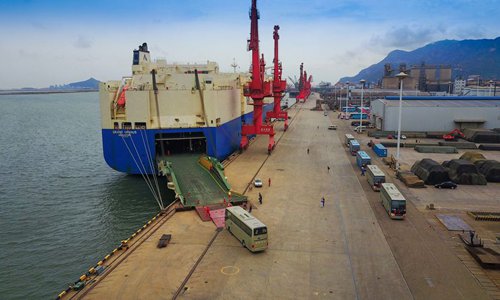HOME >> BUSINESS
Q4 trade faces uncertainties but yearly performance will be stable: official
Source:Global Times Published: 2019/10/14 16:21:16

Buses drive into a cargo ship at a port in Lianyungang, east China's Jiangsu Province, June 12, 2017. A total of 600 buses were exported to Saudi Arabia from Lianyungang port. (Xinhua/Li Bo)
Chinese officials said that the fourth quarter of foreign trade will see a complicated environment, but the yearly performance will still be stable, backed by the optimized structure.
The total value of China's foreign trade in the first three quarters of this year was 22.91 trillion yuan ($3.24 trillion), an increase of 2.8 percent on a yearly basis. China remains the world's largest trading country in goods and its share on the global market rose 0.1 percentage points, according to data released by the General Administration of Customs (GAC) during a press conference on Monday.
Exports totaled 12.48 trillion yuan, up 5.2 percent from a year earlier, and imports totaled 10.43 trillion yuan, down 0.1 percent. The trade surplus was 2.05 trillion yuan, an increase of 44.2 percent.
"In general, the figure showed a general stable foreign trade value in the first three quarters in China," said Li Kuiwen, the spokesperson of GAC, on Monday.
"It shows our trade surplus is growing bigger, and the yearly trade surplus will maintain a large growth," Wang Jun, deputy director of the department of information at the China Center for International Economic Exchanges, told the Global Times on Monday.
The European Union (EU) and the Association of Southeast Asian Nations (ASEAN) were China's two biggest trading partners in the first three quarters.
The trading value with the EU reached 3.57 trillion yuan, up 8.6 percent, which accounted for 15.6 percent of China's total foreign trade. The second-largest trade partner ASEAN accounted for 13.7 percent of total trade with a value of 3.14 trillion yuan, an increase of 11.5 percent.
The trade volume between China and the US in the same period was 2.75 trillion yuan, down 10.3 percent.
Total imports and exports with countries involved in the Belt and Road Initiative reached 6.65 trillion yuan, up 9.5 percent, or 6.7 percentage points higher than the overall growth rate of China's foreign trade, accounting for 29 percent of China's total foreign trade.
"Since the beginning of this year, the growth of the international economy and trade has slowed down, and the external environment has become more complex and grim," said Li. "In the first three quarters of this year, China's foreign trade has continued to grow, and the structure has continued to improve."
But he said the external environment of China's foreign trade development will still be complicated in the next quarter, and uncertainties are increasing.
China's foreign trade development has strong resilience, and foreign trade will remain generally stable throughout the year due to the fact that the overall foreign trade structure trend is optimized, Li said.
According to the GAC, China's total foreign trade volume rose from $1.13 billion in 1950 to a record high of $4.62 trillion in 2018, with an average annual growth rate of 13 percent. Its share of global trade in goods rose from less than 1 percent in 1950 to 11.8 percent in 2018, jumping from 28th to the first in the world. China has become a major trading partner of more than 120 countries and regions.
"The overall-stable domestic economy and tax policies supported China's foreign trade," Li noted. "Since last year, China has raised the export tax rebate rate of some products, introduced tariff reduction policies, and lowered the import value-added tax rate."
As a result, China's imports of consumer goods in the first three quarters grew by 15.3 percent. The time for customs clearance was shortened by 56.4 percent for imports and 64.7 percent on exports on a yearly basis.
However, Wang is concerned that the overall decline in imports shows that domestic demand is still weak.
Posted in: ECONOMY